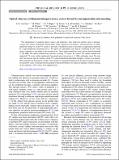Optical coherence of diamond nitrogen-vacancy centers formed by ion implantation and annealing
Author(s)
van Dam, SB; Walsh, M; Degen, MJ; Bersin, E; Mouradian, SL; Galiullin, A; Ruf, M; IJspeert, M; Taminiau, TH; Hanson, R; Englund, DR; ... Show more Show less
DownloadPublished version (1.309Mb)
Publisher Policy
Publisher Policy
Article is made available in accordance with the publisher's policy and may be subject to US copyright law. Please refer to the publisher's site for terms of use.
Terms of use
Metadata
Show full item recordAbstract
© 2019 American Physical Society. The advancement of quantum optical science and technology with solid-state emitters such as nitrogen-vacancy (NV) centers in diamond critically relies on the coherence of the emitters' optical transitions. A widely employed strategy to create NV centers at precisely controlled locations is nitrogen ion implantation followed by a high-temperature annealing process. We report on experimental data directly correlating the NV center optical coherence to the origin of the nitrogen atom. These studies reveal low-strain, narrow-optical-linewidth (<500 MHz) NV centers formed from naturally occurring N14 atoms. In contrast, NV centers formed from implanted N15 atoms exhibit significantly broadened optical transitions (>1 GHz) and higher strain. The data show that the poor optical coherence of the NV centers formed from implanted nitrogen is not due to an intrinsic effect related to the diamond or isotope. These results have immediate implications for the positioning accuracy of current NV center creation protocols and point to the need to further investigate the influence of lattice damage on the coherence of NV centers from implanted ions.
Date issued
2019Department
Massachusetts Institute of Technology. Department of Electrical Engineering and Computer ScienceJournal
Physical Review B
Publisher
American Physical Society (APS)